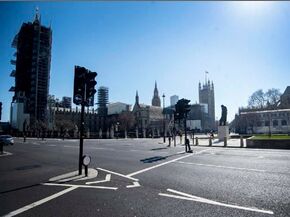欧洲多国空气污染水平大幅下降
|
The level of air pollution in London, Rome, Milan and Paris has fallen sharply since coronavirus lockdown measures have forced people indoors and off the roads. Levels of particulate matter, which can come from road transport and burning fuel, as well as nitrogen dioxide, which comes primarily from vehicle exhausts, are low across London. The UK capital's levels of ultra-fine particulate matter, known as PM2.5, are currently around half that would be normally recorded at this time of year.
The city's level of nitrogen dioxide has also been lower than the average for the previous five years, scientists say. Both pollutants have fallen by around a half since a peak in mid-February, according to data from the London Air Quality Network, analysed by the National Centre for Atmospheric Science. Meanwhile, European Environment Agency (EEA) data confirmed a 50 percent decrease in air pollutant concentrations in Rome and Milan. A Paris air quality monitoring agency has also recorded up to a 30 percent decline in overall air pollution levels there. As daily life grinds to a halt in the UK due to restricted movement to control the spread of COVID-19, air quality has improved due to a sharp reduction in traffic. 'Air quality has started to improve in many UK cities, mirroring what has been seen in other countries that have restricted travel and levels of outdoor activity,' said Professor Alastair Lewis, from the National Centre for Atmospheric Science, University of York. 'This is primarily a consequence of lower traffic volumes, and some of the most clear reductions have been in nitrogen dioxide, which comes primarily from vehicle exhaust. 'However fine particles (PM2.5) have also reduced significantly. 'In London for example, PM2.5 is noticeably lower than would be expected for this time of year at the roadside, and these reductions stretch through into the suburbs as well.' Professor Lewis said it's especially important to consider how PM2.5 levels have changed compared to what is normally seen at this time of year. While nitrogen dioxide is mainly emitted from vehicle exhausts, sources of particulate matter are more varied, ranging from road transport to burning fuel. Air pollution is linked to health problems including stroke, heart disease, lung cancer and disease, and respiratory diseases and infections, as well as stunting the growth of children's lungs. Professor William Collins, professor of meteorology at the University of Reading, said a large amount of the air pollution that is breathed in comes from traffic. And as levels of traffic pollution have plummeted with many countries in lockdown, exposure to pollutants is reduced by people staying off the streets and in their homes. France's stay-at-home orders to combat the coronavirus outbreak have produced a 20 to 30 percent decline in overall air pollution levels in Paris, according to a report from the region's air quality monitoring agency. France's lockdown has taken countless cars and delivery trucks off the roads since coming into effect on March 17, and massively reduced the number of flights at the two airports serving the capital. The Airparif report said that just two days after the self-confinement began, it registered 'a 20 to 30 percent improvement in air quality in the Paris metropolis, after nitrogen oxide emissions dropped by more than 60 percent.' The European Environment Agency's (EEA) data has confirmed a large decrease in air pollutant concentrations - in particular of nitrogen dioxide (NO2). NASA satellite images have already revealed dramatic reductions in concentrations of nitrogen dioxide in China and northern Italy, coinciding with lockdowns there. Other footage from the European Space Agency Copernicus satellite reveals a 'notable drop' in air pollution over Italy after the coronavirus lockdown. |









